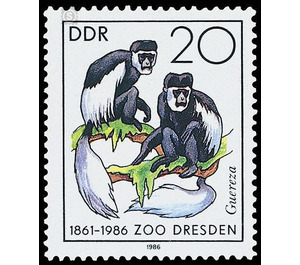125 years of dresden zoo - Germany / German Democratic Republic 1986 - 20 Pfennig
Theme: Animals
| Country | Germany / German Democratic Republic |
| Issue Date | 1986 |
| Face Value | 20.00 |
| Color | multi-colored |
| Perforation | K 14 |
| Printing Type | offset |
| Stamp Type | Postage stamp |
| Item Type | Stamp |
| Chronological Issue Number | 2762 |
| Chronological Chapter | GER-DDR |
| SID | 556681 |
| In 25 Wishlists | |
125th anniversary of ZOO Dresden On the occasion of the 125th anniversary of the zoological garden in Dresden, the Ministry of Posts and Telecommunications of the German Democratic Republic publishes four multi-colored special postage stamps. Special Cancellation from May 27 to July 26, 1986 125 Years of the Dresden Zoo Ever since the opening of the Dresden Zoo in 1861, monkeys have been introduced, and the first ape came to the zoo in 1873. Even today, this is the oldest zoological garden in the GDR as a "primate zoo", d. h. that in particular half-monkeys, animal monkeys and apes characterize its livestock. In the history of the Dresden zoo, two directors have made a name for themselves, especially through their publications on the orangutan biology. Gustav Brandes and Prof. Dr. med. Wolfgang Ullrich. It is thanks to their findings that today the breeding of these imposing apes, which are threatened with extinction in the wild, is no longer uncommon in many zoos. The zoological garden of Dresden has set itself the task to obtain by continuous breeding of several species of monkeys some representatives of the rare in the natural habitat of relatives of man to posterity. Four monkeys, which are exhibited in the Dresden Zoo and have already been bred, show the motifs of the present stamp series for the 125th anniversary of the zoo. 20 Pfennig value: Guereza (Colobus abyssinicus caudatus) This neat, belonging to the slimy monkey species, is a mountain wood dwellers of East Africa. Their closest relatives, who are known as Colobus monkeys (Kolobus = green stub) for the regression of the thumb, inhabit other parts of the African continent. All representatives of the slimy monkeys feed mainly on various leaves of their residential trees, especially the Asian representatives of the family, the langurs, are very picky. All of these monkeys have a gastric system that resembles that of ruminant ungulates. In the Dresden Zoo, therefore, a large winter supply of foliage is bundled and dried for the keeping of slimy monkeys. In addition, the zookeepers put together a suitable supplementary feed in order not to be reliant on the high-cellulosic food without exception. Colobus monkeys have been cultivated and bred in Dresden since the middle of this century. Today, the zoo has one of the largest guereza groups in all the zoos in the world.


